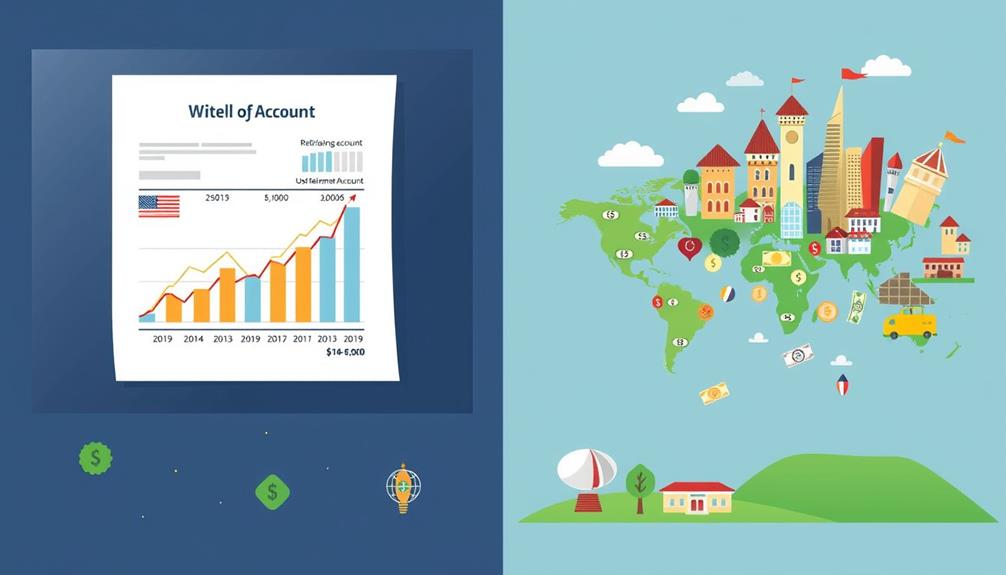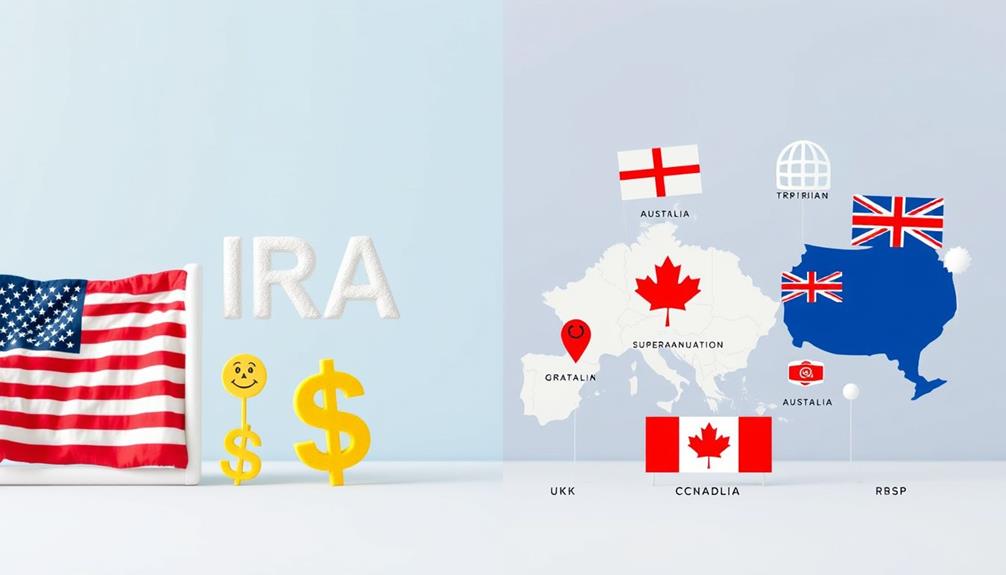When comparing U.S. IRAs to international retirement accounts, you will find significant variations. Many countries, such as Australia and the Netherlands, have mandatory systems that increase participation rates, often reaching 90%. In contrast, U.S. IRAs are optional, resulting in only around 50% participation. While U.S. IRAs provide tax benefits, they also have higher withdrawal penalties and intricate regulations. Several other countries prioritize lifetime income security, ensuring greater financial stability for retirees. Learning about these global systems can assist you in making informed decisions regarding your retirement. There is much more to discover about the benefits and challenges that each system offers.
Key Takeaways
- U.S. IRAs are voluntary and require earned income for contributions, while many countries have mandatory retirement accounts ensuring higher participation rates.
- U.S. IRAs offer tax-deferred growth, but foreign retirement accounts may allow tax-free growth or withdrawals, complicating cross-border savings.
- Participation rates in U.S. retirement accounts are around 50%, significantly lower than countries like Sweden, which achieve up to 90% participation through mandatory systems.
- U.S. retirement savings can be eroded by high administrative costs and complex regulations, unlike simpler international systems with reduced costs and clearer benefits.
- Tax implications for U.S. citizens with foreign pensions can include double taxation, unlike some international systems that provide favorable tax treatments for retirement income.
Overview of Global Retirement Systems

When you look at global retirement systems, you'll find a diverse landscape shaped by varying government policies and cultural attitudes toward savings. Countries like the Netherlands and Australia implement mandatory retirement accounts, ensuring higher pension coverage and improved retirement outcomes.
This contrasts sharply with the U.S., where the system heavily relies on voluntary plans, such as individual retirement accounts (IRAs) and 401(k)s, which often suffer from low participation rates, particularly among low-income workers. Additionally, the lack of options for diversifying retirement portfolios, such as through a gold IRA rollover, means that many Americans miss out on potential protections against inflation and market downturns.
The U.S. retirement system consists of three tiers: Social Security, Supplemental Security Income (SSI), and those voluntary plans. Unfortunately, many Americans face inadequate retirement income due to the complexity and high administrative costs of this system.
Comparatively, nations with strong retirement systems typically restrict early access to savings and guarantee lifetime income benefits, enhancing overall financial security for retirees.
In fact, U.S. pension replacement rates for low-income workers stand at only 60.6%, markedly lower than in other developed nations. This highlights the urgent need for reform in U.S. retirement systems to better align with successful international accounts and improve the financial futures of its citizens.
U.S. Retirement System Performance

The U.S. retirement system's complexity can make it tough for you to navigate your options effectively.
Many workers lack an understanding of essential financial terms like credit score and how they affect retirement planning.
With low participation rates, especially among lower-income workers, many miss out on vital benefits.
This disparity highlights the need for a clearer approach to retirement planning that better supports all Americans.
U.S. System Complexity
Steering through the U.S. retirement system can feel overwhelming due to its complexity, which includes Social Security, Supplemental Security Income (SSI), and various employer-sponsored plans. Many workers struggle to understand their options, leading to confusion about retirement savings.
Unlike countries with mandatory pension systems, the U.S. relies heavily on voluntary employer-sponsored plans, resulting in considerably lower coverage rates among citizens aged 65 and older. Additionally, the rise of self-directed investment options, such as Gold IRAs, has introduced new avenues for retirement savings, but also requires a deeper understanding of precious metal investment options.
This intricate structure comes with high administrative costs, which can erode your retirement savings over time. The shift toward defined contribution plans places even more risk on individuals, as you must take responsibility for your retirement planning.
Unfortunately, many underestimate their retirement needs and don't have control over when they can retire, which can lead to insufficient savings. The complexity of the U.S. retirement system not only complicates your path to financial security but also heightens the chances of miscalculating necessary funds for a comfortable retirement.
Understanding the nuances of Social Security benefits, individual retirement accounts (IRAs), and the overall framework can empower you to make better decisions for your future.
Participation Rate Disparities
Maneuvering the intricate U.S. retirement system reveals stark participation rate disparities that impact your savings potential. With only 13% of citizens aged 65 and older covered, compared to 58% in Australia and 72% in Denmark, access to retirement plans remains limited. The voluntary nature of employer-sponsored retirement plans contributes to a low participation rate, which hinders your ability to save effectively compared to countries with mandatory retirement accounts.
The shift from defined benefit plans to defined contribution plans has placed more responsibility on you for your retirement savings. This change often leads to inadequate retirement funds, as many Americans struggle to understand their financial needs.
Coupled with low pension replacement rates—just 60.6% for low-income workers—your income security faces serious challenges. High administrative costs and the complexity of the U.S. system further disengage workers, often leaving you underestimating necessary savings.
Improving financial literacy is essential to maneuvering this landscape and ensuring you can better participate in retirement planning. In contrast, global pension systems provide a more supportive framework, emphasizing the need for reform in the U.S. to enhance your retirement outcomes.
Comparison of Retirement Account Types

When evaluating retirement account types, you'll notice significant differences between U.S. Individual Retirement Accounts (IRAs) and international retirement systems. U.S. IRAs offer tax-deferred growth, with traditional IRAs allowing tax deductions on contributions and Roth IRAs providing tax-free withdrawals in retirement.
In contrast, many countries implement mandatory superannuation, ensuring higher participation rates and better retirement outcomes.
One essential aspect is that U.S. IRAs require earned income for contributions, which can complicate retirement savings for expatriates or those earning foreign income. On the other hand, some international systems permit contributions regardless of income source, offering greater flexibility.
Additionally, U.S. retirement accounts impose specific withdrawal penalties before age 59½, while several international systems provide more lenient access to funds under certain conditions.
Moreover, while U.S. IRAs can remain active abroad, they're still subject to U.S. tax regulations. This contrasts with some countries that allow tax-free growth or withdrawals of retirement funds under particular residency statuses.
Understanding these differences is vital as you plan for your financial future and navigate the complexities of global retirement accounts.
Challenges Facing Global Retirement Systems

Across the globe, retirement systems face significant challenges that threaten their sustainability and effectiveness. Many countries, including the U.S., are grappling with declining birth rates, which jeopardize pay-as-you-go pension systems. As these systems falter, reliance on individual retirement accounts (IRAs) grows, placing more responsibility on you to save for retirement.
High inflation and rising interest rates further strain government debt and retirement services, impacting the adequacy of retirement benefits worldwide. The shift from guaranteed pension plans to defined contribution plans increases your risk, especially in the U.S., where voluntary retirement plans dominate.
Insufficient savings among retirees is a pressing issue, worsened by longer life expectancies and escalating healthcare costs. This financial insecurity creates a crisis for many older workers, who often lack access to age-friendly employment options.
To address these challenges, significant policy reforms are necessary. Without these changes, global pension programs may struggle to provide the support you need in your retirement years.
The interconnected nature of these issues highlights the urgency for sustainable solutions in retirement systems across the globe.
Key Factors for Retirement Success

Achieving retirement success hinges on several key factors that can greatly impact your financial security in later years. One important aspect is the adequacy of benefits relative to your working wages. In the U.S. retirement system, many individuals rely on individual retirement accounts (IRAs) and employer-sponsored retirement plans, but coverage remains low, especially for those aged 65 and older. This can lead to significant disparities in retirement income.
Sustainability is another essential factor to take into account. As demographics shift, the ability of pension programs to support retirees long-term becomes paramount. A robust retirement system must adapt to these changes, ensuring that benefits remain viable for future generations.
Integrity in the governance of private providers also plays a significant role. Without transparent practices, the effectiveness of your retirement savings can be compromised. It's important to engage with trustworthy providers who prioritize your financial well-being.
Lastly, understanding retirement age is important as it directly affects your savings strategy. The earlier you start saving and investing wisely, the more secure your financial future will be, ensuring you can enjoy your retirement years without financial stress.
Tax Implications of Foreign Retirement Income

How do tax implications affect your foreign retirement income? As a U.S. citizen, maneuvering through the complexities of international tax treaties is vital for managing your tax liabilities.
If you receive foreign pension payments, you might face double taxation, but tax treaties between the U.S. and the foreign country can help reduce or eliminate this risk. These treaties often provide credits or exemptions on U.S. taxes, which can greatly impact your retirement income.
However, if your foreign pensions don't qualify as IRS-approved retirement plans, they'll be taxed as gross income in the U.S., leading to potentially higher tax liabilities.
It's important to be aware of the implications of contributions to foreign retirement accounts, as these can complicate your tax situation. You'll need to adhere to IRS regulations regarding reporting of foreign financial assets, ensuring you remain compliant while optimizing your retirement income.
Understanding these tax implications can help you make informed decisions about your foreign retirement income and minimize potential burdens.
Recommendations for U.S. Retirement Improvement

Recognizing the need for reform in the U.S. retirement system is crucial for enhancing financial security in retirement.
To improve outcomes for retirees, consider these key recommendations:
- Raise minimum pension levels for low-income individuals to guarantee basic financial security.
- Adjust retirement benefits for inflation to maintain purchasing power and combat rising costs.
- Promote automation of retirement contributions to boost participation rates in retirement savings plans, especially among younger workers.
- Expand access to affordable health care for seniors, addressing the significant impact of health care costs on retirement finances.
Additionally, strengthening Social Security and pension systems is essential for long-term sustainability.
Engaging communities in retirement planning initiatives can foster a culture of saving and support.
By implementing these strategies, we can create a more robust retirement landscape that not only improves individual financial security but also enhances the overall quality of life for retirees.
It's time to advocate for these changes to guarantee that your retirement years are as secure and fulfilling as possible.
International Perspectives on Retirement Planning

When you look at retirement planning globally, you'll notice significant differences in account structures and contribution requirements.
Countries like Australia and Singapore offer mandatory accounts that promote higher participation, while the U.S. system relies heavily on voluntary plans.
Plus, tax implications can vary greatly, impacting how you manage your retirement savings across borders.
Global Retirement Account Structures
Retirement planning varies greatly around the globe, with different countries adopting unique structures that reflect their economic philosophies and social priorities. In the U.S., individual retirement accounts (IRAs) and voluntary plans like 401(k)s dominate the landscape.
However, other countries have implemented more robust systems that often include mandatory retirement savings.
Reflect on these key differences:
- Mandatory contributions: Countries like Australia require employers to contribute to superannuation accounts, enhancing overall savings.
- Earnings-based workplace pensions: The Netherlands combines flat-rate state pensions with earnings-based workplace pensions, securing better retirement income adequacy.
- Collective pension schemes: Nations like Denmark and Sweden use these schemes to prevent leakage of retirement funds, unlike the U.S. which allows early withdrawals.
- Pension replacement rates: The U.S. struggles with lower replacement rates, particularly for low-income workers, compared to its global peers.
These global retirement systems highlight the disparities in how different structures can impact retirement income adequacy, making it essential for you to reflect on these factors when planning your future.
Tax Implications Across Borders
Maneuvering the complexities of retirement planning often extends beyond domestic borders, especially for U.S. citizens living or working abroad. You need to be aware of the tax implications tied to foreign retirement accounts. Contributions to these accounts mightn't qualify as IRS-approved retirement plans, which could lead to taxation of your contributions as gross income in the U.S.
When it comes to retirement income from foreign pensions, it may be subject to U.S. taxation. However, tax treaties can help you reduce or even eliminate double taxation risks. The tax treatment of this income varies considerably depending on the country, so understanding specific tax treaties is essential for optimizing your tax liabilities.
Additionally, if you have foreign assets exceeding $50,000, you must report them on your tax returns. Under FATCA, there are further reporting requirements for foreign accounts exceeding $10,000.
Given these complexities, seeking professional tax advice is highly recommended to navigate your international tax obligations and maximize your retirement benefits effectively.
Contribution Requirements and Limits
Many people are surprised to learn how diverse contribution requirements and limits can be across different countries. In the U.S., you've got an annual contribution limit of $6,500 for IRAs, increasing to $7,500 if you're over 50. In contrast, countries like Australia impose higher limits thanks to mandatory employer contributions.
Here are some key differences in contribution structures around the world:
- Mandatory contributions: Countries like Singapore require contributions from both employees and employers into the Central Provident Fund, reaching a total of 37% for younger workers.
- Combined rates: In the Netherlands, the pension system mandates contributions up to 27.65% of gross salary from both parties.
- Automatic enrollment: Denmark's approach has led to higher participation rates compared to the U.S.'s reliance on voluntary contributions.
- Minimum contributions: Malaysia mandates a minimum of 11% from employees and 13% from employers via the Employees Provident Fund.
These differences not only affect your retirement savings but also highlight how various pension systems can encourage or discourage participation in retirement accounts.
Frequently Asked Questions
Who Has the Best Retirement System in the World?
If you're looking for the best retirement system, the Netherlands tops the list. Its strong pension framework and high public confidence make it a standout, followed closely by Iceland and Denmark with their effective retirement policies.
How Does US Retirement Age Compare to Other Countries?
When you compare retirement ages, you'll see the U.S. allows early retirement at 62, while other countries like the U.K. and Australia set ages around 65 to 67, reflecting varying approaches to retirement planning.
Are Foreign Retirement Accounts Taxable in the Us?
Yes, foreign retirement accounts can be taxable in the U.S. You'll need to report any foreign retirement income on your tax returns. Understanding tax treaties is essential to minimize double taxation and optimize your liabilities.
Where Does the US Rank in Retirement?
The U.S. ranks 22nd out of 47 countries in retirement systems, scoring a C+. With low pension coverage and replacement rates, it trails behind countries like the Netherlands and Denmark, which offer more robust retirement options.
Conclusion
As you navigate the intricate web of global retirement systems, remember that your financial future is like a garden—nurture it wisely. While U.S. IRAs offer unique advantages, international accounts can provide a richer soil for your retirement plans. Embrace the lessons learned from around the world and cultivate a strategy that blossoms into financial security. With the right tools and insights, you can guarantee your retirement garden flourishes, no matter where you choose to plant your roots.









